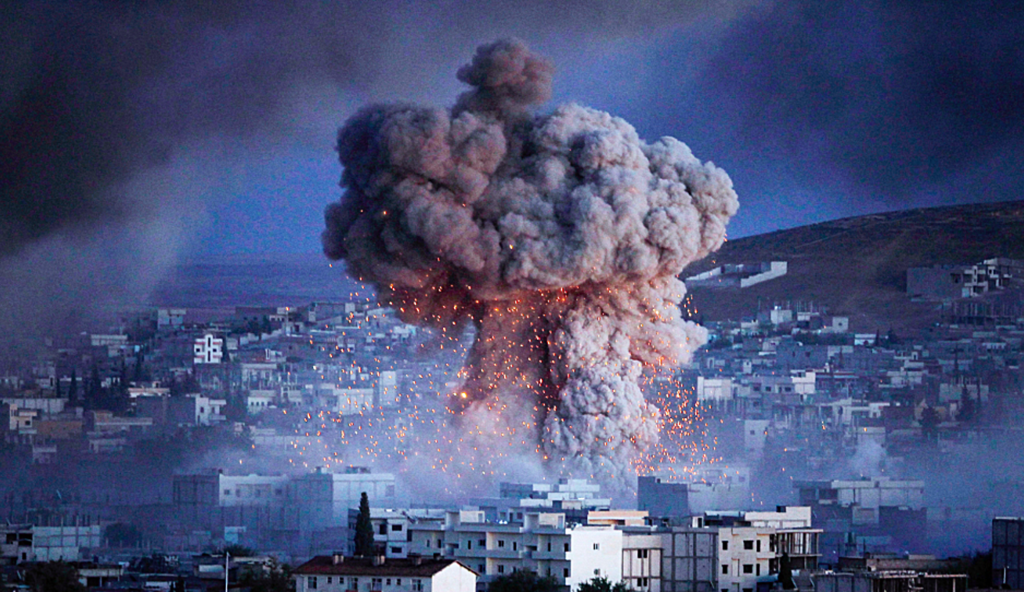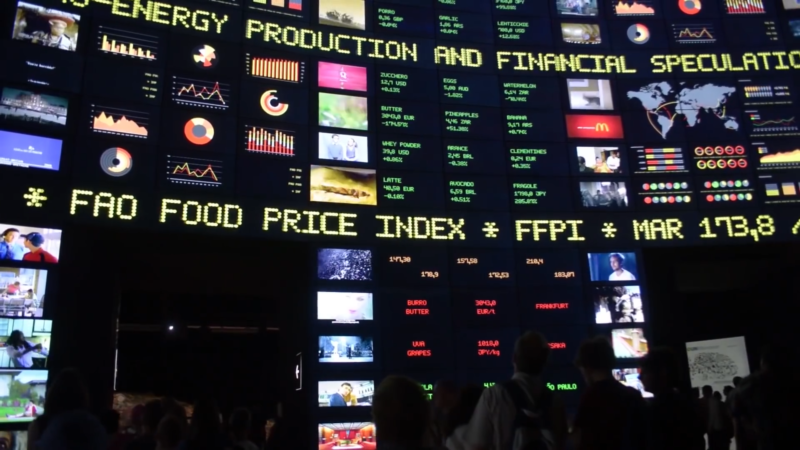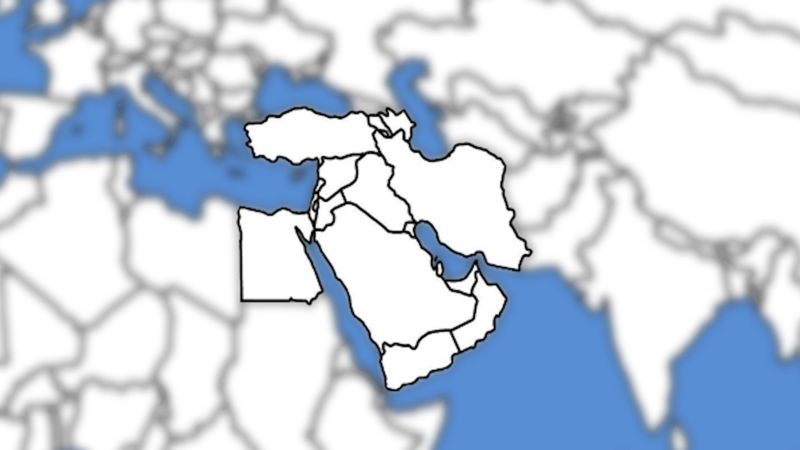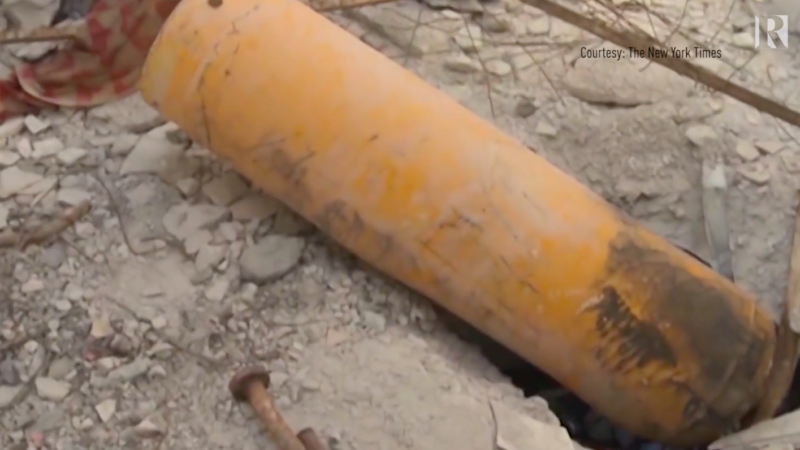There are 22 members of the Arab League, 21 of which are clients of the US. Syria is the remaining Arab state whose allegiances lie elsewhere. Syria is a client state of Russia and Iran is their only ally. The US want Syria’s army to be US trained, the Qatari pipeline to go through Syria. The Syrian conflict has never been about democracy, or human rights. It has always been about Assad’s relationship with Iran. In the first of this two-part series, we examine the media myths in relation to Syria, and the extent to which corporate media-state power continues to demonise the country’s president through propaganda.

Virtually unknown among large swaths the general public both in Britain and the U.S is the fact that Bashar-al Assad’s secular government won the first contested presidential election in Ba’athist Syria’s history on July 16, 2014, which was reported as having been open, fair and transparent. American Peace Council delegate, Joe Jamison, who was allowed unhindered travel throughout Syria, stated:
“By contrast to the medieval Wahhabist ideology, Syria promotes a socially inclusive and pluralistic form of Islam.
We [the USPC] met these people. They are humane and democratically minded…. The [Syrian] government is popular and recognised as being legitimate by the UN. It contests and wins elections which are monitored.
There’s a parliament which contains opposition parties – we met them. There is a significant non-violent opposition which is trying to work constructively for its own social vision.”
Jamison added:
“Our delegation came to Syria with political views and assumptions, but we were determined to be sceptics and to follow the facts wherever they led us”, he said. “I concluded that the motive of the US war is to destroy an independent, Arab, secular state. It’s the last of this kind of state standing.”
The notion that the United States government and its allies and proxies, want to see the destruction of Syria’s pluralistic state under Assad destroyed, is hardly a secret. Indeed, one of Washington’s key allies in the region, Israel, has conceded as much. The claim by Israel’s defence minister, Avigdor Lieberman, that Assad’s removal is the empires “ultimate goal”, would appear to be consistent with the notion that the aim of the U.S government is to stymie the non-violent opposition inside Syria. Washington has been engaged in this strategy since early 2012 after having deliberately helped scupper Kofi Annan’s six point peace plan.
Members of the Syrian opposition within a newly reformed constitution who wanted to participate in democratic politics have instead been encouraged by the Western axis – as a result of bribing government forces to defect and through funding the Free Syrian Army – to overthrow the Assad government by violent means.
As commentator Dan Glazebrook put it:
“Within days of Annan’s peace plan gaining a positive response from both sides in late March, the imperial powers openly pledged, for the first time, millions of dollars for the Free Syrian Army; for military equipment, to provide salaries to its soldiers and to bribe government forces to defect. In other words, terrified that the civil war is starting to die down, they are setting about institutionalising it.”
It’s the concept of the ‘institutionalisation’ of civil war in Syria that is being encouraged in the corporate mass media. In truth, the notion that the violence in Syria can be characterised as a civil war is a misnomer. US Peace Council delegate, Madeleyn Hoffman was right to dismiss the concept outright in relation to Syria:
“It’s not Assad against his own people”, she said. “It is president Assad and the Syrian people all together – in unity – against outside mercenary forces and terror organisations.”
This contention is consistent with the analysis of Stephen Gowans who recalls that in early 2011, reporters from Time magazine and the New York Times conceded that Assad commanded broad support, was popular, and that Syrians exhibited little interest in protest.
“For the last quarter of a century, the US and its allies have waged highly destructive campaigns of economic warfare against Syria and Iraq, the economic equivalent of nuclear war,” writes Gowans in his critically acclaimed book Washington’s Long War on Syria, “and have done so because they are opposed to Ba’ath Arab Socialist efforts to bring politics and the economics of the Arab world under the control of those who live and work in the Arab world.”
Time’s Rania Abouzeid said:
“Assad had a favorable reputation, especially among the two-thirds of the population under 30 years of age, and his government’s policies were widely supported.”
The journalist added:
“Even critics concede that Assad is popular and considered close to the country’s huge youth cohort, both emotionally, ideologically and, of course, chronologically. Unlike the ousted pro-American leaders of Tunisia and Egypt, Assad’s hostile foreign policy toward Israel, strident support for Palestinians and the militant groups Hamas and Hezbollah are in line with popular Syrian sentiment.”
Assad, in other words, has legitimacy. The Time correspondent added that Assad’s “driving himself to the Umayyad Mosque in February to take part in prayers to mark the Prophet Muhammad’s birthday, and strolling through the crowded Souq Al-Hamidiyah marketplace with a low security profile” had “helped to endear him, personally, to the public.”
This wouldn’t be possible if he was regarded by the Syrian people to be a dictator.
The depiction of Syria by the corporate media as a non-secular Islamist fundamentalist state comparable to the totalitarianism of the Gulf Peninsula states akin to the Arab Spring, is a complete fantasy. On the contrary, Syria is a relatively progressive secular and pluralist country whose military are fighting a proxy war initiated and fueled from without.
The numbers highlighted below support this thesis.
Dr Declan Hayes, who for many years has been living in Syria, offers additional insights:
“If this were a genuine revolution or revolt against a tyrannical regime, the sort of despots one gets in Saudi Arabia, Bahrain, Kuwait or Turkey, one would expect most Syrian moderates to support it.
Iran’s 1979 Islamic Revolution, to take one pertinent example, famously had the support of the shopkeepers, hawkers and students of Tehran who ended up sending the Shah, his secret police and their toadies scuttling for American-supplied bolt holes overseas.
Whatever its rights or wrongs, Iran’s Islamic Revolution had widespread support, as do Bahrain’s moderate protesters, who brave the henchmen of Saudi Arabia every time they protest against that truly autocratic regime.
Moderate Alawites, Shias or Christians cannot support the Syrian insurgents as all the rebels are agreed that the Alawites and Shias must be exterminated and the Christians driven into exile, if they are not first also exterminated.”
Hayes continued:
“All of Syria’s Christian leaders support, implicitly at least, the government of the Syrian Arab Republic, not least because, a few token rebels apart, there is no area in rebel-held Syria where they can openly practice their religion or live without perpetual fear.
Nor is there anywhere the moderate rebels control that Christians and other minorities can be safe from kidnapping by these same moderates, who will then sell them on to their more violent partners in crime, in much the same way the moderate rebels sold on the Ma’lulah nuns and the two American journalists who were recently beheaded. There is, in short, no way Syria’s Christians, Shias or Alawites, who do not have a death wish, can support the moderate rebels.”
If Assad was really a tyrant intent on suppressing the democratic impulses of his people as opposed to the leader of a legitimate government fighting international Islamist terrorism, why did 18,000 civilians express joy after having been liberated by Assad’s forces from terrorist controlled areas?
Independent journalist, Vanessa Beeley, who spoke with civilians on the ground in east Aleppo as it was being liberated, emphasized what she described as the universal “sheer jubilation and celebration at their liberation by the Syrian-Arab Army and the Syrian government.”
These kinds of testimonies have been totally absent from the corporate media.
If the general public were to be made aware of the reactions of the Syrian people in the aftermath of their liberation, it would immediately bring the false propaganda perpetuated by the said media crashing down in flames.
Commentator John Wight made the point that:
“History will not be kind to those who have propagated the lie that something approximating to a democratic revolution has been underway in Syria.
On the contrary, the country and its people have suffered the depredations of an Islamic Khmer Rouge, intent on ‘purifying’ a multicultural and multi-religious society of minority communities that are able to trace their existence in this part of the world back over a millennia and more.”
“The vast majority of Syrians, without whose support the government would have collapsed long before now, utterly reject the ideology of these extremists — thousands of non-Syrians who’ve descended on the country from across the Muslim world and beyond like a plague of locusts, have taken advantage of the destabilisation of the region wrought by Washington and its allies in recent years.”
There is disagreement among academics and reporters as to what constituted the spark that was the catalyst resulting in the ensuing destabilisation of the country. However, there is general agreement that on 17 March, 2011, rioting occurred at the Syria-Jordan border town of Daraa involving hundreds not, as is often claimed, thousands or tens of thousands of people. The rioting was guided by a largely Islamist agenda, and wasn’t a mass uprising typical of the Arab Spring depicted in much of the Western media.
A review of press reports in the weeks immediately preceding and following the riots, offers no indication that Syria was in the grips of a revolutionary struggle. On the contrary, reporters representing Time magazine and the New York Times referred to the government as having broad support, of critics conceding that Assad was popular, and of Syrians exhibiting little interest in protest. This narrative is consistent with the indifference shown to the “Day of Rage” ‘protests’ on February 4 and 5 that preceded it. The protests “fizzled,” reported Time.
The magazine reported that two jihadist groups that would later play lead roles in the insurgency, Jabhat al-Nusra and Ahrar al-Sham, were already in operation on the eve of the riots, while a mere three months earlier, leaders of the Muslim Brotherhood voiced “their hope for a civil revolt in Syria.” The Muslim Brothers, who had decades earlier declared a blood feud with Syria’s ruling Ba’athist Party, objecting violently to the party’s secularism, had been embroiled in a life and death struggle with secular Arab nationalists since the 1960s, and had engaged in street battles with Ba’athist partisans from the late 1940s.
In response to the violent attacks by hundreds of Islamist activists (what we in the West would term ‘terrorists’) on government buildings – that involved arson – president Assad responded by agreeing to the jihadists demands. This included releasing their comrades from state prisons. The US State Department had acknowledged that political Islam was the main opposition in Syria and that jihadists made up the principal section of opposition groups likely to be incarcerated.
“Clerics demanding that Damascus release all political prisoners was equal in effect to the Islamic State demanding that Washington, Paris, and London release all Islamists detained in US, French and British prisons on terrorism charges.
“This wasn’t a demand for jobs and greater democracy, but a demand for the release from prison of activists inspired by the goal of bringing about an Islamic state in Syria.
The call to lift the emergency law, similarly, appeared to have little to do with fostering democracy and more to do with expanding the room for jihadists and their collaborators to organise opposition to the secular state.”
Writing shortly after the violence at Daraa, professor of Economics, Michel Chossudovsky noted that the burning of government buildings by jihadists:
“had all the appearances of a staged event involving, in all likelihood, covert support to Islamic terrorists by Mossad and/or Western intelligence. Government sources point to the role of radical Salafist groups (supported by Israel). Other reports have pointed to the role of Saudi Arabia in financing the protest movement.”
Jeremy Salt, associate professor in Middle Eastern History and Politics at Bilkent University, Ankara, wrote:
“The armed groups are well armed and well organised. Large shipments of weapons have been smuggled into Syria from Lebanon and Turkey. They include pump action shotguns, machine guns, Kalashnikovs, RPG launchers, Israeli-made hand grenades and numerous other explosives. It is not clear who is providing these weapons but someone is, and someone is paying for them.”
Reports (suppressed in the Western media) indicating that the number of policemen killed at Daraa (seven) was more than the number of demonstrators killed (four), is hardly indicative of the brutal actions of a government intent on oppressing its own people.
Clearly, the outbreak of violence in Daraa, undertaken by less than a thousand jihadists in support of their imprisoned comrades, was not representative of the will of the mass of the Syrian people. Indeed, the subsequent pro-government rally in the capital twelve days after the Western fomented violence in Daraa (which can be viewed below), is indicative of widespread support for Assad, and far exceeds in number the hundreds of protesters who turned out in the Syria-Jordan border town to burn buildings and cars and clash with police.
Aleppo isn't being besieged by Syria's army, it's being liberated from terrorists
— the Lemniscat (@theLemniscat) November 7, 2016
Clip from pro-govt rally in Aleppo 2011#StandWithAleppo pic.twitter.com/V7M315XiZy
The tens of thousands of Syrians who gathered at central bank square in Damascus in support of their president, rather predictably, was portrayed in the Western media as an anti-government demonstration. The Guardian, for instance, reported the rally as a “military crackdown against civilians”. This kind of misinformation prompted Russia and China to veto a European-backed UN security council resolution threatening sanctions against the Syrian regime “if it did not immediately halt its military crackdown against civilians”.
The prospect of a lengthy war against Syria provides a boost to the profits of the arms and weapons companies while simultaneously reining in Russian and Iranian influence in the region. According to Charles Glass, in order to help achieve this, U.S tax payers’ money “has been used to fund terrorist groups from the very beginning.”
The author, journalist and film-maker proffered the U.S rationale for this course of action:
“Iran is president Assad’s only ally in the region, and Assad is the only client state of Russia in the entire Arab war.
Remember, there are only twenty-two members of the Arab League, twenty-one of whom are client American states, and Russia wasn’t going to give the one that remains up.
So from the point of view of the U.S, they want to have all twenty-two.”
Glass continued:
“Moreover, they want the Syrian army to be U.S trained, and they want a Qatari pipeline to go through Syria. They want to dominate the whole region and Syria is the missing piece.
In addition to which, because Syria supported Hezzbollah in Lebanon, which the Israeli’s have never forgiven them for, they wanted to break the bridge with Tehran.
For the outside powers, it’s never been about human rights and democracy inside Syria. That’s not the issue. The issue has always been about Assad’s relationship with Iran.”
Glass’s assertions are supported by Craig Murray, and have also been corroborated by Wikileak cables.
In 2012, a Pentagon document obtained by Judicial Watch spelled out that the jihadist terrorist opposition in Syria – who have burned down churches and massacred the world’s oldest Christian communities – are the major forces driving the insurgency in the country. It’s jihadi factions who countries like the US, Saudi Arabia, Britain and France are actively supporting.
Two years later (2014), David Cohen, US Treasury under-secretary for terrorism and financial intelligence, claimed that middlemen from Turkey and Iraq’s Kurdistan region buy black market oil from ISIS that earns the terror group some $1 million a day.
In his testimony before the Senate Armed Services Committee in September 2014, General Martin Dempsey, then chairman of the US Joint Chiefs of Staff, was asked by Senator Lindsay Graham whether he knew of “any major Arab ally that embraces ISIL”?
Dempsey replied:
“I know major Arab allies who fund them.”
In other words, the most senior US military official at the time had confirmed that ISIS were being funded by the very same “major Arab allies” that had just joined the US-led anti-ISIS coalition.
Dempsey’s testimony is consistent with information contained within a leaked US State Department memo, dated 17 August 2014, which states that:
“We need to use our diplomatic and more traditional intelligence assets to bring pressure on the governments of Qatar and Saudi Arabia, which are providing clandestine financial and logistic support to Isis and other radical groups in the region.”
The prospect of regime change in Syria and elsewhere would not be possible without a sophisticated and compliant media PR propaganda machine that underpins the military objectives of the state. Journalist Patrick Cockburn has revealed the embedded nature of corporate-state power in helping to foment imperialist wars:
“It would be simple-minded to believe that this very appealing and professional PR for the Syrian armed opposition is all their own work.
Foreign governments play a fairly open role in funding and training opposition media specialists.
One journalist of partly Syrian extraction in Beirut told me how he had been offered $17,000 a month to work for just such an opposition media PR project backed by the British government.”
The openly stated positions of the imperial powers and their media accomplices completely debunks the notion that the motives of both are benign. It is clear that as far as elite Western power is concerned, continuous war is preferred to a genuine and lasting peace, particularly in resource-rich parts of the world where humanitarian concerns are regarded as an obstacle to the establishment of geopolitical and economic interests.
In relation to Iraq, for example, the notion that the NATO alliance did everything it could to obstruct a peaceful resolution in the country was overwhelming. Peace is not conducive to profits. Similarly, in relation to Libya, the notion that UN Security Council Resolution 1973 was used to assist in “facilitating dialogue” was rendered absurd by the subsequent rejection by the West of proposals put forward by the African Union (AU).
“If stopping the killing [in Libya] had been the real aim, NATO states would have backed a ceasefire and a negotiated settlement, rather than repeatedly vetoing both.”
In Libya, as in Iraq, a negotiated settlement – peace that could have averted a bloodbath – was an obstacle to be avoided, not a goal. Why? While the UN mandate referred specifically to the protection of civilians under threat of attack, the Guardian’s Richard Norton-Taylor commented, “it was quite clear from the start that regime change was the objective.”
Former UK ambassador, Craig Murray, commented: “NATO action in Libya went way beyond what the Security Council had actually authorised, which was a no fly zone to protect civilians, a ceasefire, and negotiations between the parties.”
It was NATO’s political support for violent resistance in Libya, its air campaign in support of anti-Gaddafi forces, its flat rejection of all ceasefire and peace proposals, and its demand that Gaddafi “step down”, that created the conditions for civil war and, as planned, regime change.
The same imperial powers have been pursuing a similar strategy in Syria. This became evident the moment they rejected the six-point Annan peace plan that was accepted on 27 March, 2012 by president Assad.
It is clear that the Western powers and their middle east regional allies view the suffering of innocent people at the hands of Islamist fundamentalists like ISIS and other proxies, who they arm and fund, as a price worth paying in order to secure their geopolitical and economic goals in the region.
Regime change, against a backdrop of terrible human suffering, is regarded by the imperial powers as preferable to the establishment of a secular and pluralistic government under president Assad. The right of Syria’s minority communities to be able to continue to live under a non-sectarian umbrella, protected under international law, and to ensure the civil liberties of these people are upheld and protected, is not a priority as far as the British and United States governments’ are concerned.
Read Part 2 here: We examine the role the UK government is playing in bringing about regime change in Syria, as well as evaluating what the Labour party’s foreign policy position is likely to be.

Why is the West looking around the world for a war?

Has the time come for the people of West Asia to reclaim political and media narratives stripped from them by Western imperialism?

Are the chickens finally coming home to roost for the BBC?